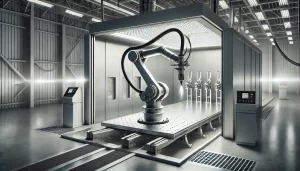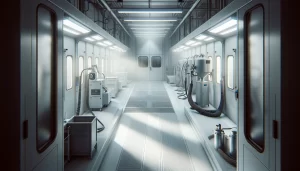When it comes to operating a paint booth, fire safety is one of the most critical factors to consider. paintbooth.coms involve flammable materials, chemical vapors, and high-powered equipment, all of which can create serious fire hazards if not properly managed. That’s why fire codes are in place to ensure safe operation and minimize the risk of fire-related accidents. Whether you’re setting up a new paint booth or maintaining an existing one, understanding and following fire code requirements is essential for both safety and compliance.
Fire codes for paint booths are designed to protect workers, facilities, and the environment. These regulations typically come from organizations like the National Fire Protection Association (NFPA), the Occupational Safety and Health Administration (OSHA), and local building and fire codes. Among the most referenced standards is NFPA 33, which specifically addresses spray application processes using flammable or combustible materials.
Ventilation and Airflow Safety
One of the biggest risks in a paint booth is the buildup of flammable vapors. Without proper ventilation, these vapors can accumulate and create an explosive environment. Fire codes require that paint booths have adequate ventilation to keep the air clean and prevent flammable concentrations from forming. This means using exhaust systems that pull air out of the booth at a rate sufficient to dilute vapors below dangerous levels.
The air movement must also be properly directed. It should flow in a way that prevents pockets of flammable mist or fumes from lingering. Additionally, the airflow must be strong enough to remove vapors but not so strong that it disrupts the spraying process. The ventilation system must also include explosion-proof fans and ducts, ensuring they do not create sparks that could ignite flammable vapors.
Fire Suppression Systems
No matter how careful you are, fires can still occur, so fire codes require that paint booths have fire suppression systems in place. These systems help detect and extinguish fires before they spread. Many booths are equipped with automatic fire suppression systems that use dry chemicals, foam, or carbon dioxide to put out flames quickly.
Fire suppression systems must be inspected regularly to ensure they are in working order. Some systems have manual activation points that allow workers to trigger them if they spot a fire before the system detects it. Additionally, portable fire extinguishers must be readily accessible in case of emergencies. NFPA guidelines specify the type of fire extinguisher that should be used, typically Class B extinguishers that are designed for flammable liquids.
Electrical Safety and Explosion Prevention
paintbooth.coms use electrical equipment for lighting, ventilation, and spraying, but electrical components can be a major fire hazard if not installed correctly. Fire codes require all electrical wiring, light fixtures, and outlets inside a paint booth to be explosion-proof or rated for hazardous locations. This means they are built in a way that prevents sparks or heat from igniting flammable vapors.
It’s also important to properly ground all equipment inside the booth. Static electricity can build up and create a spark, which is why fire codes mandate that all metal parts of the booth, including spray guns and containers, be grounded to prevent static discharge.
Another key requirement is that open flames and ignition sources must be kept far away from the booth. This includes smoking, welding, or any activity that produces sparks. Facilities with paint booths should have designated no-smoking areas and clearly marked signage to ensure compliance.
Proper Storage of Flammable Materials
Paints, thinners, and solvents are highly flammable, which is why fire codes have strict regulations on how they should be stored. These materials must be kept in approved safety cabinets that are designed to contain fires and prevent ignition. Containers should always be sealed tightly when not in use to limit the release of vapors.
Fire codes also specify the maximum amount of flammable liquids that can be stored inside a facility at one time. If large quantities of paint or solvents are needed, businesses may be required to use a flammable liquid storage room that meets fire safety standards.
Regular Maintenance and Inspections
Fire safety is an ongoing process. Even if a paint booth is installed correctly and meets all fire codes, it must be regularly maintained to ensure continued compliance. Fire codes often require facilities to schedule routine inspections of ventilation systems, fire suppression systems, and electrical components. Filters must be cleaned or replaced frequently to prevent the buildup of overspray, which can be a fire hazard.
Employees should also be trained on fire safety procedures. They should know how to handle flammable materials safely, what to do in case of a fire, and how to properly use fire extinguishers. Many fire codes require businesses to conduct fire drills and maintain clear emergency exit routes for quick evacuation.
Compliance with Local Regulations
While NFPA 33 and OSHA standards provide a national framework for fire safety in paint booths, it’s important to check with local fire departments and building codes as well. Some areas may have additional requirements based on environmental concerns or specific risks in the region.
Failing to comply with fire codes can result in serious consequences, including fines, shutdowns, and increased liability in the event of a fire. That’s why it’s essential for businesses to stay up to date with the latest fire safety standards and work closely with inspectors to ensure full compliance.
Final Thoughts
Fire safety is a top priority when operating a paint booth, and fire code requirements are in place to keep workers and facilities safe. Proper ventilation, fire suppression systems, explosion-proof electrical components, and safe storage of flammable materials all play a role in minimizing fire hazards. Regular inspections and employee training are equally important in ensuring a safe work environment.
By following fire codes and implementing best practices, businesses can prevent dangerous situations, avoid costly penalties, and create a safer workplace for everyone involved.
How We Can Help with Your Paint Booth Needs
At Paint Booth, we specialize in providing top-tier paint booths and finishing equipment tailored to your business requirements. Whether you need a standard-size paint booth or a custom solution designed for your unique projects, our expert team is here to assist you every step of the way. From design to installation, we ensure that your equipment meets the highest industry standards, enhancing both your productivity and the quality of your finishes. Contact us today to find the perfect paint booth solution for your business!




